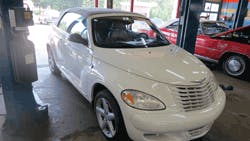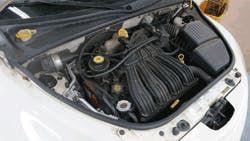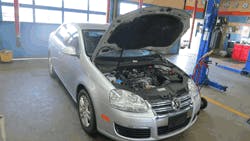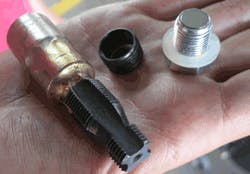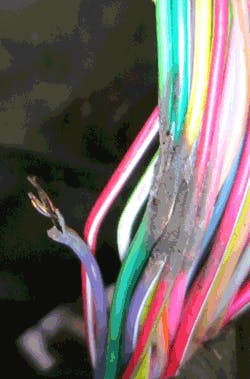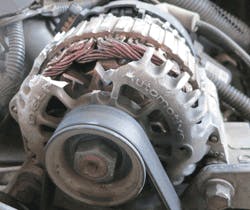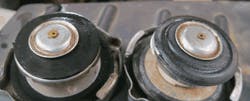Everybody who pulls a wrench has run afoul of vehicles with bulky engines stuffed in very small engine rooms. I wonder sometimes if at least some of the vehicle manufacturers have returned to the old “stovepipe” way of doing things, where design engineers would come up with a body they liked and then send the prototype up the pipe to the powertrain folks, usually with the instructions to cram an existing engine/transmission platform into the new body.
The PT Cruiser and the VW Beetle are pretty much the same way, even equipped with their four bangers, and when you shoe-horn a Turbocharger in there, it makes things even tighter.
Retro vehicles became a hot item about 15 years ago, with cars like Ford’s reintroduction of the Thunderbird, the rebirth of the VW Beetle, the limited edition Plymouth Prowler, Chevy’s HHR, Dodge’s Challenger, Chevy’s Camaro and the venerable little PT Cruiser, which has been just about as popular as the Beetle.
Honeymoon Purchase
The son of a retired colleague of mine had purchased this clean little convertible PT while he was on a honeymoon trip with his new wife in Florida. They had been driving the car around for about five days sightseeing when it sprang a coolant leak, so they visited a shop down in Florida. They were told the engine oil pan would need to be replaced at a cost of $500, and the oil had been drained from the pan – the car had been driven in for service, and now, because of the oil pan problem, it was wrecker fodder. This young owner was somewhat disillusioned as to how a coolant leak on a vehicle he had been driving for several days could morph into a $500 oil pan replacement. He placed a call to Mom and Dad, who took a trailer and spent 16 hours or so retrieving the Cruiser, which wound up in one of my service bays.
The first thing I noticed when I got it on the lift was a short ¾-inch coolant hose that had been replaced along with the new clamps. It seemed to me that during that hose repair the shop had noticed that the engine oil pan was sporting a rubber drain plug, which they might have dislodged while replacing that kind of hard-to-get to hose. When they saw that the threads in that aluminum pan had been stripped out, they priced out an oil pan and the labor to replace it. And, to be honest, I can sort of understand what they were thinking. In this litigious society of ours, the last thing they wanted was for a customer to get a few miles down the road after their repair to have that rubber plug pop out and weld the engine together. So they priced out the oil pan to protect themselves as well as the customer. That being said, a traveling customer will usually balk at a $500 estimate under circumstances of this kind. In other words, the shop didn’t actually do anything wrong, but when a customer goes in for a coolant leak and gets an estimate like that, especially when they’re eight hours south of home, they aren’t likely to pony up with half a grand to pay for something they aren’t sure about with the kind of family lifeline that was available.
I called the parts store and ordered an 18 mm drain plug with the same thread pitch as an oxygen sensor, but that parts store couldn’t get a thread tap without my having to wait five days for it.
Many Happy Returns
The son who owns this car lives about 100 miles to the north, and so, before delivering it to him, they drove it around for a few days and found that, while it ran cool most of the time, it would sometimes run warmer than others, i.e., a bit too far above the center of the gauge for their comfort. I asked if the warmer times were happening in traffic or at the drive-thru, and they said they had noticed it on the highway but not in town. We did the cheap and easy and popped a new thermostat in, re-bled everything, made sure it was full of coolant, and sent them on their way again.
They drove it a few more days without incident, then headed off to the north to deliver it. They spent a day or so up there while their son drove it around (they’re retired), and he made an 80 mph interstate run to another city, and on that trip he experienced some mild overheating, along with a flickering oil light. And so the PT returned to us again. To begin, we replaced the oil sending unit again, swapping the original one out as defective, but not before checking to see what the actual oil pressure was. Even with the engine toasty warm and idling, the actual pressure was a comfortable 30 psi.
In-Between Jobs
In the meantime, these same folks brought a 1997 Chevy Van with an A/C leak, and when we applied dye with the refrigerant charge, ran it for awhile and shot it with the black light, the compressor lit up like it was radioactive. That one got a compressor, a new orifice, an accumulator and a gaggle of new O-rings. While the front registers were shoving artic air into those two seats, the rear unit still wasn’t cooling. It probably needed an expansion valve and some flushing, but they needed to use the van, so we would address that when we were done with the PTs and they had time to release the van for awhile.
What that meant to me was that the Jetta had been chest deep to the driver on the inside of the car, usually the kiss of death for all manner of electronics. Nothing would talk to the J2534 flasher or any scan tool, and when I called Joey Henrich at AE tools, he told me that nothing would talk on that Jetta unless a factory radio was installed. Further, if an aftermarket unit was installed, the scan tool would be fried as soon as it was connected. I sent the Jetta’s owner in search of a replacement OEM radio, and that job wound up on hold. We also had a percolating Caravan because of a Chinese radiator (see illustration) and a wire harness issue on a 2000 Ranger that had disabled the A/C.
Another ‘Happy’ Return
The next happy return on the PT happened when they discovered the coolant was low in the surge bottle, and when they tried to add coolant to bring it to the line, it went straight to the pavement – fingering a brand new breach in the surge bottle. Further, they had seen the oil light flickering again, and this was getting peculiar enough that I was wondering if the oil sending unit wire was shorted to ground, but we couldn’t locate a short. I did notice in passing, however, that disconnecting the unit seemed to cause that light to illuminate (sometimes), which makes normal diagnosis of a circuit like this kind of troublesome and misleading. That led to an Identifix search, which revealed that quite a few shops had seen flickering oil lights because of aftermarket oil pressure switches on Cruisers. Because we had to order a surge tank to replace the newly cracked one on that PT, we snagged a $25 oil pressure sender from Chrysler on the same order and swapped that pressure switch out again.
Explanations and Scheduling
That postulation of mine led them to ask how the problem they were having with this PT differed from the other one, and so I shifted into teaching mode, and my answer was that the other one had a turbocharged engine and only overheated at high speeds. That would be, according to my hypothesis, a migration of the fire from the power stroke on at least one hole shoving heat past a compromised head gasket into the coolant.
We ended that conversation with the agreement that they would monitor the 2002 Cruiser to gauge the rate at which the coolant was leaving, and that they would monitor the 2005 PT for overheating at normal speeds. One way or another, both of those cruisers will probably need head gaskets, but that won’t happen until this fall, because the semester was at an end. Sometimes I have to kick the can down the
road until the time is right, and both of these Cruisers can cruise until it’s time to do the work.
